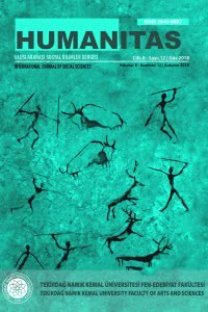KURAMDAN KURMACAYA: SERGE DOUBROVSKY’NİN FILS, PHILIPPE FOREST’İN L’ENFANT ETERNEL VE MARIE DARRIEUSSECQ’İN LE BEBE ADLI ROMANLARINDA BİR ÖZKURMACA İNCELEMESİ
1977'de Serge Doubrovsky, Fils'te başlattığı kendi uygulamasını nitelemek için özkurmaca terimini keşfetmiştir. Kitabının dış arka kapağında şu tanıtımı vermektedir: “Bütünüyle gerçek olgulardan ve olaylardan oluşan kurmacayı eğer özkurmaca diye adlandırırsak, yeni ya da geleneksel olsun roman yapısı ve bilgeliğinden uzak bir biçimde, bir serüvenin dilini, dilin serüvenine bırakmış bir tür olarak tanımlarız onu. (Tilbe, 2019, p.55). Kurmaca ile gerçeklik arasında yer alan özkurmacanın amacı her şeyden önce yazınsaldır. Gerçekte, yeniötesi yazın eleştirisi bu yeni yazınsal türün sınırlarını belirlemeyi denemektedir. Biz, bu çalışmayı gerçekleştirmek için üç özkurmaca yazarı seçtik: Philippe Forest, Marie Darrieussecq ve Serge Doubrovsky. Her üçünün de L’Enfant Eternel, Fils et Le Bébé romanları aracılığıyla özkurmaca üzerine geliştirdikleri kendi kuramları bulunmaktadır. Bu incelemede, söz konusu yazarların romanları aracılığıyla kuramlarını nasıl ortaya koyduklarını anlamaya ve açıklamaya çalışacağız.
Anahtar Kelimeler:
darrieussecq, doubrovsky, forest, özkurmaca, yeniötesi
FROM THE THEORY TO THE FICTION: AN AUTOFICTIONNAL STUDY ABOUT FILS BY SERGE DOUBROVSKY, L’ENFANT ETERNEL BY PHILIPPE FOREST AND LE BÉBÉ BY MARIE DARRIEUSSECQ
In 1977, Serge Doubrovsky invented the term autofiction to qualify his own practice initiated in Fils. In the bur accompanying the book we can read this: "Fiction, of events and facts strictly real; autofiction if you will, of having entrusted the language of an adventure to the adventure of language, out of the wisdom and the syntax of the novel, traditional or new”. Being anchored both in fiction and reality, the stake of the autofiction is above all literary. Indeed, postmodern literary criticism has been trying to define the boundaries of this new literary object. Today, autofiction is the postmodern form of the questions the authors ask themselves about their identity, their intimacy. Thus, to carry out this research we chose three Autofiction authors: Philippe Forest, Marie Darrieussecq and Serge Doubrovsky. All three have their own theory on autofiction and put their theories into practice through their novels: L’Enfant Eternel, Fils and Le Bébé. We can try to understand why authors of autofictions feel the need to go through the theory to accompany their stories.
Keywords:
autofiction, darrieussecq, doubrovsky, forest, postmodernity,
___
- Barraband, M. & Gassmann, X. (2005). Entretien avec Marie Darrieussecq. La lettre de l'enfance et de l'adolescence, 1(59), 9-16. https://www.cairn.info/revue-lettre-de-l-enfance-et-de-l-adolescence-2005-1-page-9.htm#
- Budak, E. (2019). Özkurmaca roman incelemesi: Patrick Modiano’nun La place de l’étoile’i. (Mémoire de master inédit). Université de Tekirdağ Namık Kemal, Tekirdağ.
- Chemin, A. (2013, 2 août). Fils, père de l’autofiction. Le Monde. https://www.lemonde.fr/culture/article/2013/07/18/fils-pere-de-l autofiction_3449667_3246.html
- Civelek, K. & Tilbe, A. (2016). Frédéric Beigbeder’nin Romantik Egoist adlı karma benli anlatısı: özyaşamöyküsü mü, yeniötesi günlük mü, özkurmaca roman mı? Border Crossing, 6(1), 27-46.
- Colonna, V. (1989). L’Autofiction. Essai sur la fictionnalisation du soi en littérature. (Thèse de Doctorat inédite). EHESS, Paris.
- Darrieussecq, M. (1996). L’Autofiction, un genre pas sérieux. Paris: Poétique.
- Darrieussecq, M. (2002). Le Bébé. Paris: Editions P.O.L.
- Doubrovsky, S. (1977). Fils. Paris: Editions Galilée.
- Elibol, A. (2018). Analyse autofictionnelle de L'autre qu'on adorait de Catherine Cusset. (Mémoire de master inédit). Université de Tekirdağ Namık Kemal, Tekirdağ.
- Forest, P. (1997). L’Enfant éternel. Paris: Éditions Gallimard.
- Forest, P. (2001). Le roman, le je. Nantes: Pleins feux.
- Forest, P. (2007). Le roman, le réel et autres essais. Nantes: Editions Cécile Defaut.
- Gasparini, P. (2004). Est-il je? Roman autobiographique et autofiction. Paris: Editions du Seuil.
- Gasparini, P. (2008). Autofiction, une aventure du langage. Paris: Éditions duSeuil. Gasparini, P. (2019). Autofiction. C. Delory-Momberger (Ed.) Dans Vocabulaire des histoires de vie et de la recherche biographique (pp. 35-36). Toulouse, France: ERES.
- Grell, I. (2015). Autofiction. Paris: Armand Colin.
- Jameson, F. (2007). Le postmodernisme ou la logique culturelle du capitalisme tardif. Paris: Les Editions Beaux Arts de Paris.
- Latour, M. J. (2008). Entretien avec Philippe Forest, L'en-je Lacanien, 2(11), 181-200. https://www.cairn.info/revue-l-en-je-lacanien-2008-2-page-181.htm
- Lejeune, P. (1975). Le pacte autobiographique. Paris: Seuil.
- Lyotard, J-F. (1979). La condition postmoderne. Paris: Editions de Minuit.
- Mallarmé, S. (1961). Pour un tombeau d’Anatole. Paris: Seuil.
- Tilbe, A. & Turğut, H. (2013). Romain Gary´den yeniötesi bir özkurgusal roman: Şafakta Verilmiş Sözüm Vardı, Turkish Studies- International Periodical for the Languages, Literature and History of Turkish or Turkic. 8(10), 651-658.
- Tilbe, A. (2019). Yeniötesi yazında özkurmaca. London: Transnational Press London. Varga, A. K. (1990). Le récit postmoderne. Littérature, 77, 3-22.
- ISSN: 2147-088X
- Yayın Aralığı: Yılda 2 Sayı
- Başlangıç: 2013
- Yayıncı: Namık Kemal Üniversitesi
Sayıdaki Diğer Makaleler
ETİK İLE POLİTİKANIN KESİŞİMİNDE “İHTİMAM”
MAHREMİYETİN DÖNÜŞÜMÜ VE İLETİŞİM ARAÇLARI
NİTEL ARAŞTIRMALARDA KONUMSALLIK VE DÜŞÜNÜMSELLİK: YAKINLIK VE MESAFE ARASI MÜZAKERE
BİRİNCİ DÜNYA SAVAŞINDA TEKFURDAĞ SANCAĞINA YAPILAN GÖÇLER
SORUN ODAKLI GENÇLİK YAZINI VE GENÇ AKTİVİSTLER
DÎVÂNU LUGÂTİ’T-TÜRK’TEKİ su- FİİLİ ÜZERİNE
Seçil KESKİN, Selim HOVARDAOĞLU
LÉVI-STRAUSS’UN YAPISALCILIĞINI ALTÜST ETMEK: CİNSİYET BELASI’NI “BÜKÜLMÜŞ BRİCOLAGE” OLARAK OKUMAK
